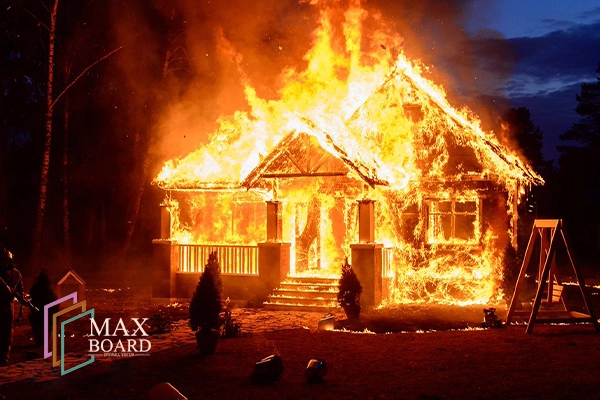In 2025, fire safety starts with upgraded smoke alarms, routine electrical inspections, smart fire alert systems, using fire-resistant building materials, having a practiced escape plan, and keeping an updated emergency kit. Prevention, preparedness, and modern technology are key to protecting your home and family from fire-related risks.
Introduction: Why Fire Safety Still Matters in 2025
Despite advances in home technology and awareness campaigns, residential fires remain a serious threat in 2025. Thousands of homes are still affected each year due to electrical faults, unattended cooking, heating malfunctions, or outdated safety measures. But the good news is: most of these fires are preventable.
Staying updated with the latest fire safety tips 2025 is essential for every homeowner. As fire risks evolve due to climate change, electrical overloads, and outdated systems, learning how to protect your home is more critical than ever. In this guide, we’ll explore expert-backed fire safety tips 2025 to help you minimize danger and ensure peace of mind.
In this guide, we’ll walk you through practical fire safety tips for 2025, from kitchen safety to smart home integration—so you can feel more secure in your space and make the best choices for your family’s safety.
1. Understanding the Most Common Causes of House Fires
To effectively prevent residential fires, it’s essential to understand where and how they typically begin. In 2025, while technology has improved fire detection, human error and overlooked hazards remain the leading causes.
Top Fire Triggers at Home
- Cooking Accidents (Still #1):
Unattended pots, oil overheating, or forgetting something on the stove remain the most frequent fire causes. - Electrical Malfunctions:
Overloaded outlets, outdated wiring, or malfunctioning appliances spark thousands of fires annually. In smart homes, improper installation of devices adds to the risk. - Heating Equipment Failures:
Portable heaters placed too close to furniture or curtains, unclean chimneys, and furnace malfunctions are major wintertime threats. - Smoking Indoors:
Cigarettes, vapes, or incense left unattended can ignite soft furnishings instantly. - Candles and Open Flames:
Popular for ambiance, candles cause hundreds of home fires yearly—especially when left burning overnight or near flammable decor.
What’s New in 2025?
- Smart Device Overloads:
With more homes using interconnected smart plugs, charging hubs, and AI-enabled appliances, electrical loads are higher than ever. If improperly managed, these can overheat. - Battery Fires (EVs & Power Banks):
Lithium-ion batteries used in power banks, scooters, and electric vehicles pose a significant new risk—especially during overnight charging.
Knowing these risks helps homeowners take proactive steps—not only in buying safer materials, but also in forming better habits.
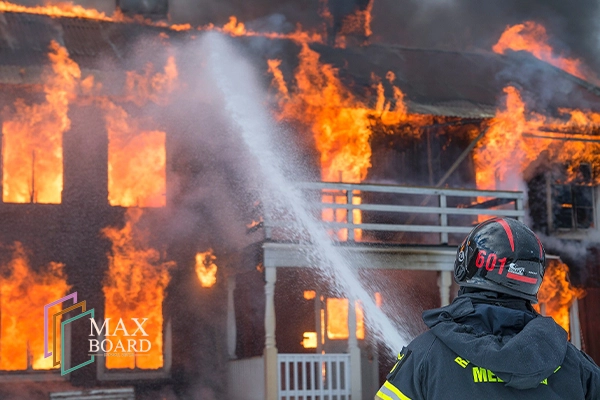
2. Essential Fire Safety Tips for the Modern Home
Preventing a fire at home doesn’t require expensive equipment—it starts with awareness and a few smart habits. In 2025, where homes are more connected and crowded with tech than ever, these safety tips are critical.
Electrical Safety
- Use certified power strips with built-in surge protection.
- Avoid daisy-chaining extension cords—plugging one into another is a fire hazard.
- Upgrade old wiring if your home is over 20 years old.
- Hire a licensed electrician for any electrical additions or smart home upgrades.
Kitchen Safety
- Never leave cooking unattended, especially when frying with oil.
- Install a kitchen fire extinguisher within arm’s reach of the stove.
- Keep towels and paper products far from burners.
- Use a timer or smart assistant to remind you food is on the stove.
Heating & Fireplace Safety
- Have chimneys inspected annually.
- Keep flammable objects at least 1 meter away from heaters or radiators.
- Install carbon monoxide detectors alongside smoke alarms.
- Don’t use the oven as a space heater—yes, people still do this.
Candles, Vapes & Smoking
- Switch to flameless LED candles—they look just as nice.
- Never smoke in bed or near fabrics.
- Always extinguish incense or candles before leaving the room.
Battery & Charging Safety (2025 Update)
- Charge power banks and scooters away from flammable materials.
- Use original chargers only—cheap ones can overheat or short-circuit.
- Never charge devices under pillows or blankets where heat builds up.
Emergency Readiness
- Install smoke alarms in every bedroom and hallway.
- Test smoke detectors monthly.
- Create an evacuation plan and practice it with your family.
- Keep a fire extinguisher on each floor of your home.
3. How to Create a Fire-Safe Home Design in 2025
Designing a beautiful home is important—but designing one that keeps your family safe is essential. In 2025, fire-safe architecture goes beyond just alarms and extinguishers. It’s about smart layouts, material choices, and anticipating how fire behaves in your space.
Choose Fire-Resistant Building Materials
Use non-combustible materials for walls, ceilings, and floors—especially in high-risk areas like kitchens and garages.
- Gypsum boards with fire rating (like MaxBoard FR)
- Magnesium Oxide (MgO) panels
- Concrete and brick over untreated wood
- Metal frames instead of timber for load-bearing structures
Install Fire-Rated Doors
Fire-rated doors slow down the spread of flames and smoke, buying valuable time for escape and reducing structural damage.
- Choose minimum 30-minute rated doors for bedrooms and hallways.
- Ensure self-closing hinges are installed, especially in multi-story homes.
Smart Window Design
Windows can be a weak spot in a fire. Tempered or fire-rated glass can delay breakage and help keep fire out longer.
- Double-glazed windows with fire-resistant frames (e.g., steel or aluminum)
- Limit skylights made of plastic or acrylic—they melt quickly.
Compartmentalization: Stop Fire from Spreading
Break up open-plan spaces with fire-resistant barriers.
- Fire-rated drywall partitions between living and utility areas
- Closable vents that prevent fire from traveling via HVAC systems
- Enclosed stairwells with smoke seals
Integrate Ventilation Safely
Ventilation is vital, but improperly designed systems can spread fire and smoke quickly.
- Use fire dampers in ductwork
- Avoid shared ducts between kitchens and bedrooms
- Keep exhaust fans clean and functioning
Plan for Electrical Safety in Design
- Dedicated circuits for high-power appliances
- Built-in charging stations with automatic shutoff
- Conduits routed away from insulation or flammable materials
4. Fire Safety Technologies Every Modern Home Needs
Advancements in home fire safety technology can mean the difference between a near-miss and a devastating loss. In 2025, a wide range of intelligent systems and smart devices are available to detect, prevent, and mitigate fire incidents more effectively than ever before.
Smart Smoke Detectors
Modern smoke detectors don’t just make noise—they send real-time alerts to your phone, integrate with home automation systems, and even detect both smoke and carbon monoxide simultaneously. Many models are voice-enabled and self-testing.
Wireless Interconnected Alarms
Instead of isolated devices, opt for interconnected alarms. If one alarm goes off in the basement, all alarms in the house will sound, alerting occupants on every floor.
Automatic Fire Suppression Systems
These go beyond the traditional sprinkler. New systems use fine water mist, foam, or gas-based suppression to extinguish fires without causing water damage—ideal for kitchens, garages, or areas with electronics.
Fire Safety Apps & Home Integration
Smartphone apps now allow you to monitor the status of alarms, battery levels, and receive emergency alerts while you’re away. Integrated systems can shut off gas lines or unlock smart locks during a fire event for easier evacuation.
Fire-Rated Doors and Smart Exits
Modern homes increasingly use fire-rated construction panels in doors and wall assemblies to provide additional fire resistance. Some even integrate with smart home systems to illuminate exit paths or unlock automatically during emergencies.
Automatic Fire Extinguishers
Under-the-hood fire suppressors and ceiling-mounted extinguishers in garages or mechanical rooms are gaining popularity, especially for homes with solar panels or EV charging stations.
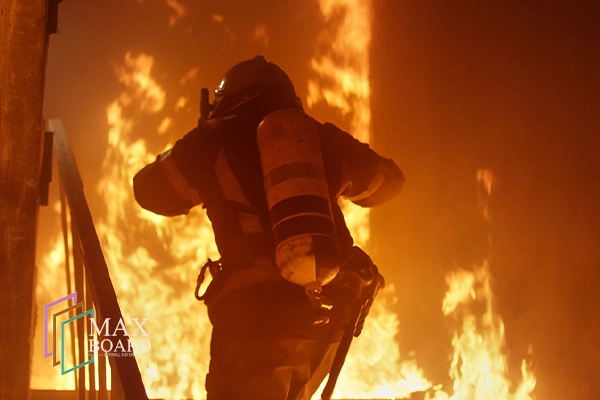
5. Common Causes of Residential Fires & How to Avoid Them
Each year, residential fires result in thousands of fatalities and billions of dollars in property damage globally. Understanding the leading causes—and knowing how to prevent them—can drastically reduce the risk in your home.
1. Kitchen Fires
Cause: Unattended cooking, overheated oil, flammable items near stoves
Prevention Tip: Always stay in the kitchen while cooking. Keep flammable objects (like paper towels and curtains) away from the stovetop. Install a heat-sensitive fire alarm above cooking areas and keep a fire extinguisher nearby.
2. Electrical Fires
Cause: Overloaded outlets, frayed cords, outdated wiring
Prevention Tip: Avoid plugging multiple high-wattage appliances into the same outlet. Have your home’s electrical system inspected periodically by a licensed electrician. Unplug small appliances when not in use.
3. Candles and Incense
Cause: Tipping over, proximity to curtains or upholstery
Prevention Tip: Use flameless LED candles or keep real candles on stable, heat-resistant surfaces far from anything flammable. Always extinguish them before leaving a room.
4. Smoking Indoors
Cause: Lit cigarettes falling on carpets, bedding, or furniture
Prevention Tip: If you smoke, do so outside. Never smoke in bed, and always use deep ashtrays. Douse cigarette butts in water before disposal.
5. Heating Equipment
Cause: Space heaters placed too close to flammable materials
Prevention Tip: Keep space heaters at least 3 feet (1 meter) from curtains, bedding, or furniture. Use models with automatic shut-off if tipped over. Have your chimney cleaned annually if using fireplaces.
6. Faulty Appliances
Cause: Malfunctioning dryers, microwaves, or irons
Prevention Tip: Regularly inspect appliances for signs of wear. Clean dryer vents and filters, and replace damaged cords. Buy certified products from reputable brands.
7. Flammable Construction Materials
Cause: Homes built or renovated with combustible materials like untreated wood or flammable cladding
Prevention Tip: Use fire-resistant building materials like fireproof construction panels and non-combustible wall boards during renovations or new construction to slow down fire spread and minimize damage.
6. Emergency Preparedness Plans for Families
In 2025, being proactive about fire safety means more than just having the right gadgets—it requires a well-rehearsed family plan. Knowing what to do in the first few minutes of a fire can mean the difference between survival and tragedy.
Create a Fire Escape Plan
Every household should have a clear, visual map of escape routes from each room. Mark windows and doors, and ensure each family member knows two ways out of every space.
Identify Primary & Secondary Exits
Teach children how to open windows safely in case the main door is blocked by smoke or flames. Practice how to check if a door is hot before opening.
Designate a Meeting Point
Pick a safe, visible location outside the house—like a neighbor’s driveway or a nearby tree—where everyone meets after escaping.
Practice Regular Drills
Run fire drills at least twice a year. Include nighttime drills to simulate a real emergency. Time how long it takes to evacuate and adjust your plan accordingly.
Include Pets in the Plan
If possible, assign one adult to help pets exit safely. Keep leashes and carriers by the door, and include pet stickers on windows to alert firefighters.
Store Emergency Contacts
Program important numbers—like the fire department, neighbors, and nearby family—into every mobile phone. Post them visibly in your home too.
Teach “Stop, Drop, and Roll”
If clothes catch fire, everyone—especially kids—should know to stop, drop to the ground, and roll to smother the flames.
7. The Cost of Fire Recovery vs. Prevention
Many homeowners underestimate the true cost of a house fire—not just in property damage, but in emotional trauma, insurance headaches, and time lost. Understanding the financial and personal toll of recovery can highlight why fire prevention is one of the smartest investments in 2025.
Financial Cost of Recovery
A single home fire can cause tens to hundreds of thousands of dollars in damage. Even with insurance, deductibles, exclusions, and slow claim processing mean you’re often left covering:
- Temporary housing for your family
- Replacement of furniture, electronics, clothing
- Repairs or complete rebuilding
- Structural inspections and fire code compliance
- Loss of irreplaceable items (photos, documents)
According to the NFPA, the average cost of a residential fire in the U.S. exceeds $30,000.
Emotional & Mental Toll
Beyond finances, fires leave deep emotional scars:
- PTSD and anxiety in children and adults
- Pets lost or traumatized
- Family routines disrupted for months
- Long-term fear of fire recurrence
Prevention can’t erase trauma, but it drastically reduces the chance you’ll experience it.
Prevention Costs Less
Compare the cost of prevention:
- Smoke alarms: $15–$50 each
- Fire extinguishers: $30–$70
- Fire escape ladders: $30–$100
- Fire-resistant furniture covers: $40–$100
- Fire-rated wall panels (like MGO boards): Higher upfront cost, but protect for decades
For under $500, most families can fully equip their homes with life-saving fire safety tools.
8. How Smart Home Devices Are Enhancing Fire Safety in 2025
The rise of smart home technology has revolutionized how we prevent, detect, and respond to home fires. In 2025, these innovations are not just about convenience—they’re life-saving tools that every homeowner should consider.
AI-Powered Smoke and Heat Detectors
Modern detectors go beyond beeping. With built-in AI and real-time monitoring, they can:
- Distinguish between steam and smoke
- Send alerts to your smartphone instantly
- Integrate with home assistants like Alexa or Google Home
- Automatically notify emergency services if you’re away
Example: Google Nest Protect not only detects smoke but also voices the room it’s in, helping families evacuate more efficiently.
Smart Electrical Outlets and Monitors
Electrical fires are a leading cause of house fires. Smart plugs and energy monitors can:
- Detect overloads or overheating
- Shut off appliances remotely
- Send warnings before a short circuit occurs
Integrated Fire Response Systems
In 2025, homes can be equipped with automated emergency systems, such as:
- Smart fire sprinklers activated by heat sensors
- Fire doors that close automatically to compartmentalize flames
- Lights that guide you to exits in the dark or smoke
Connected Fire Extinguishers
Yes, even extinguishers are getting smart! Some models now:
- Send refill reminders
- Alert you if they’ve been used or moved
- Link to fire alarms for real-time location guidance
Real-Time Data and Fire Analytics
Smart home hubs aggregate data on:
- Temperature trends
- Smoke levels
- Room-by-room safety status
This data can be shared with fire departments for faster, targeted response—especially important in large properties or multi-unit dwellings.
Interconnected Safety
Best of all, smart devices work together:
- A smoke detector triggers smart locks to open exit doors
- The HVAC system shuts down to prevent smoke spread
- Emergency contacts receive instant alerts
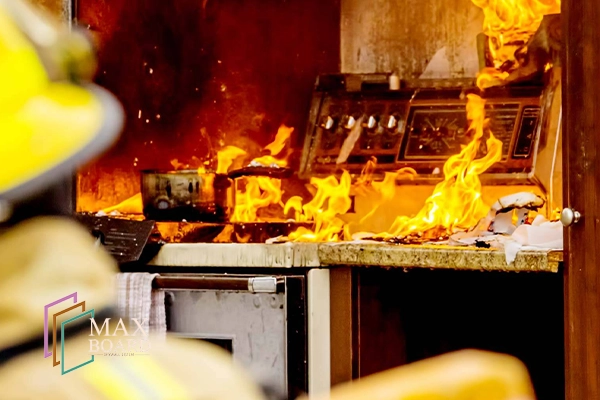
9. Checklist: How Fire-Safe Is Your Home in 2025?
Wondering if your home meets modern fire safety standards? Use this comprehensive 2025 checklist to assess your fire readiness and identify areas for improvement. It’s not just about having smoke alarms—it’s about being proactive and protected.
Fire Detection
✅ Smart smoke detectors installed in all major rooms
✅ Heat detectors in the kitchen and garage
✅ Detectors connected to mobile alerts and voice assistants
✅ Monthly test reminders set on your smart home system
Fire Containment
✅ Fire-rated doors on bedrooms and stairwells
✅ Fire-resistant building materials used in construction (e.g., gypsum boards, MGO panels)
✅ Fire dampers in HVAC ducts to stop flame spread
✅ Fire barriers between floors or apartment units
Electrical Safety
✅ Smart plugs and circuit breakers monitoring usage
✅ No overloaded power strips or extension cords
✅ Annual electrical inspection scheduled
✅ Appliances unplugged when not in use
Suppression Equipment
✅ ABC-rated fire extinguishers on every floor
✅ Smart extinguishers connected to home automation
✅ Fire blankets in the kitchen
✅ Fire suppression system (sprinklers or foam) in high-risk zones
Escape and Evacuation
✅ Two clear escape routes from every bedroom
✅ Emergency lights or glow-in-the-dark exit signs
✅ Central meeting point defined for all family members
✅ Fire drills practiced at least twice a year
Smart Integrations
✅ Interconnected smoke detectors (when one rings, all do)
✅ Auto-lock release and garage opener on fire alert
✅ Notifications to emergency contacts and local fire station
✅ Real-time safety dashboard on smartphone
💡 Scoring Tip:
- 25–30 ✅: Excellent – Your home is a fire safety fortress!
- 15–24 ✅: Good – Some improvements can elevate your protection.
- Under 15 ✅: High risk – Immediate upgrades are recommended.
10. Fire Safety for Families with Kids and Seniors
Protecting vulnerable household members—especially young children and elderly adults—requires extra care and thoughtful planning. Their limited mobility, slower reaction times, and lack of awareness can turn even a small incident into a life-threatening emergency.
🔸 Safety Measures for Children
- Install tamper-proof outlets to prevent accidental fires from inserted objects.
- Keep matches, lighters, and candles out of reach and stored in locked drawers.
- Use stove knob covers and heat-sensor alarms in kitchens to prevent burns or fire ignition.
- Teach kids emergency basics: what a smoke alarm sounds like, how to crawl under smoke, and where to go.
- Label the child’s room for first responders, especially if the window is not easily accessible.
🔸 Safety Tips for Elderly Residents
- Choose smoke detectors with voice alerts or flashing lights, which are more effective than beeping tones for those with hearing loss.
- Install grab bars and non-slip flooring in bathrooms and kitchens to reduce fire-starting falls.
- Avoid electric blankets and space heaters unless they are modern, auto-shutoff models.
- Arrange bedrooms near exits for faster escape.
- Ensure medications, eyeglasses, and walking aids are kept near the bed.
🔸 Unified Family Plan
- Create a family evacuation map showing all exits, escape routes, and the designated meeting point.
- Practice the “2 ways out” rule for every room: one door and one window.
- Assign helpers: One adult should be responsible for assisting kids or seniors during a fire.
- Teach 911 protocols and ensure phones are easily accessible.
🔸 Technology to the Rescue
Smart home systems can add vital seconds during emergencies:
- Use bedroom motion sensors to detect if a child or elder is still inside.
- Automated alerts sent to family, neighbors, or caretakers.
- Connect fire alarms with smart locks and garage doors for instant exit readiness.
👪 Fire safety is a family responsibility. By planning ahead and tailoring your strategy to vulnerable members, you turn every second into a life-saving opportunity.
11. Outdoor Fire Hazards & How to Prevent Them
While indoor fire safety often gets most of the attention, outdoor fire hazards can be just as dangerous—especially in homes with yards, balconies, or proximity to forested or dry areas. Wildfires, grilling accidents, and improperly stored materials have caused massive losses that could have been prevented with basic precautions.
Common Outdoor Fire Hazards
🔸 Barbecues & Grills
- Grease buildup can ignite flare-ups.
- Gas leaks from faulty hoses or valves can lead to explosions.
- Charcoal embers remain hot for hours, even when not glowing.
🔸 Dry Landscaping
- Dried leaves, pine needles, or overgrown grass act like kindling.
- Trees with low-hanging branches spread flames to roofs and structures.
🔸 Fire Pits & Outdoor Heaters
- Portable heaters or fire pits without proper clearance can ignite nearby objects.
- Wind can carry embers into the house or onto flammable surfaces.
🔸 Outdoor Storage
- Propane tanks, gasoline containers, and paint cans stored improperly can become explosive during a fire.
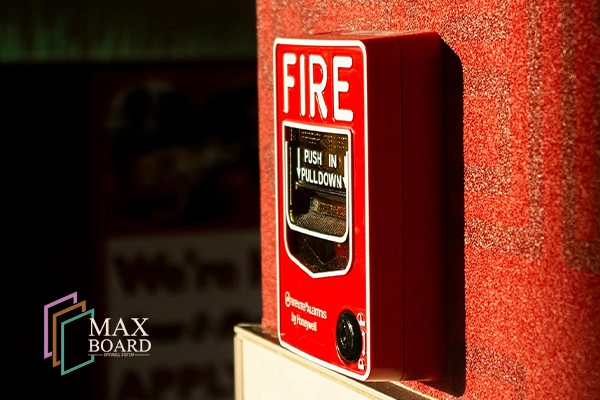
Fire Prevention Tips for Outdoor Areas
- Clear vegetation: Maintain at least 3 feet of defensible space around buildings. Remove dried plants, weeds, and debris regularly.
- Use non-combustible landscaping: Replace wood mulch with gravel, stone, or fire-retardant bark.
- Inspect BBQ equipment before each use. Check for gas leaks, and clean grills after every cookout.
- Place fire pits or heaters on flat, fireproof surfaces—never on wood decks or grass.
- Store flammables in ventilated, labeled, and fire-rated cabinets or sheds.
Special Tips for Wildfire-Prone Areas
- Install ember-resistant vents and metal mesh screens on windows and soffits.
- Use fire-rated exterior cladding and roofing, such as metal, concrete, or fiber cement.
- Keep hoses and water supplies ready in case of flying embers.
- Enroll in local emergency alert systems and establish a wildfire evacuation plan.
Outdoor safety is an extension of indoor fire prevention. Your yard, balcony, or storage area can either shield your home—or expose it to serious fire threats. Choose wisely and inspect often.
12. Final Checklist & Resources for Homeowners
Ensuring fire safety in 2025 means taking a proactive, room-by-room, zone-by-zone approach. This final checklist will help you quickly assess your home’s preparedness and guide you toward safer living.
Fire Safety Home Checklist
🔸 General
- Smoke detectors installed in every room and hallway
- Carbon monoxide detectors in sleeping areas
- Fire extinguishers accessible and recently serviced
- Emergency escape plan practiced by all family members
- Fireproof safe for important documents
🔸 Kitchen
- Stove and oven cleaned regularly
- No flammable materials near heat sources
- Fire blanket easily accessible
- Appliances unplugged when not in use
🔸 Bedrooms & Living Areas
- No overloaded outlets or extension cords
- Heaters kept at least 3 feet from anything flammable
- Curtains and upholstery away from space heaters
- Candles never left unattended
🔸 Electrical System
- Regular inspection by a licensed electrician
- Circuit breakers clearly labeled
- No buzzing or overheating outlets
- Surge protectors used for electronics
🔸 Outdoors
- BBQ and fire pit at least 10 feet from structure
- Flammable liquids stored in metal containers
- Dry vegetation cleared regularly
- Garden hoses and tools ready in wildfire-prone areas
Additional Resources
- National Fire Protection Association (NFPA): nfpa.org
- Ready.gov (FEMA Emergency Preparedness): ready.gov/fires
- Home Fire Safety Check Tools (Red Cross): redcross.org/fire
- Smoke Alarm Guidance (USFA): usfa.fema.gov
Final Reminder
Fire safety is a continuous effort, not a one-time fix. Revisit your home’s fire safety plan every 6–12 months, especially if you remodel, add appliances, or move into a new home. Your life—and the lives of your loved ones—depend on it.
For even more in-depth guidance on materials that enhance fire resistance in buildings, check out our article on fire-resistant building materials. Combining structural protection with fire safety tips 2025 ensures your home is not only safe but also built to last.
Want to dive deeper into the science behind fire-resistant materials?
Don’t miss our expert guide: Why Fire Safety Matters in Modern Construction

